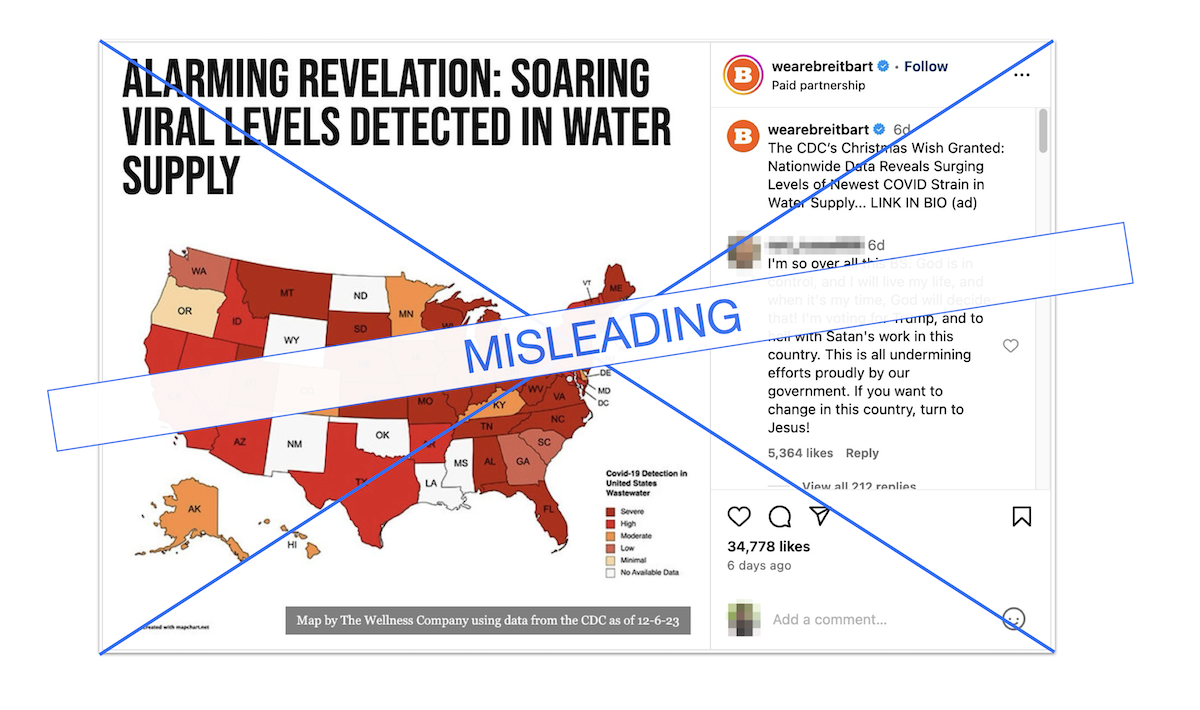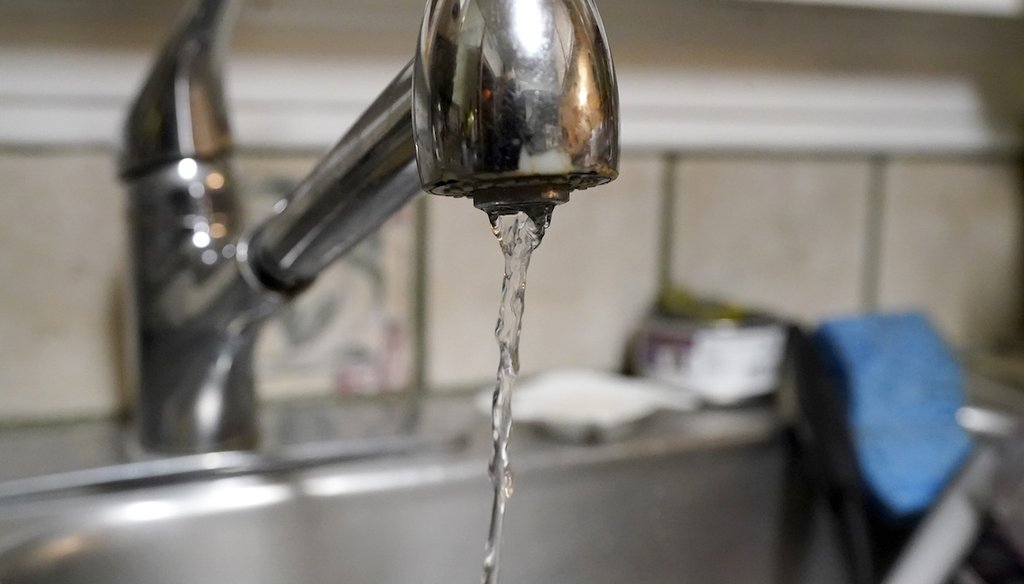

Our only agenda is to publish the truth so you can be an informed participant in democracy.
We need your help.


Water pours out of the faucet on Feb. 20, 2021, in Dallas. (AP)
The Centers for Disease Control and Prevention is reporting "very high" wastewater viral activity level for COVID-19. Wastewater surveillance helps track infection trends, but viral activity in wastewater doesn’t mean the water supply is contaminated.
Wastewater surveillance is conducted before the wastewater is treated, and there is no evidence to date that someone has become infected with COVID-19 because of exposure to treated or untreated wastewater, the CDC said.
The Environmental Protection Agency reported that COVID-19 virus has not been detected in drinking-water supplies.
In the middle of the 2023 winter holiday season, conservative news organization Breitbart shared an alarming Instagram post that claimed the coronavirus had tainted the U.S. water supply.
"The CDC’s Christmas Wish Granted: Nationwide Data Reveals Surging Levels of Newest COVID Strain in Water Supply," read Breitbart’s Dec. 27 post. The caption was shared alongside a U.S. map that featured several states shaded in red and orange. The post encouraged people to follow a link in the account’s bio.
In the Instagram post comments, users speculated, writing, "it’s almost like it was put there on purpose" and "Infecting people thru the water supply? Seems like something the government would do."
"Water supply" typically refers to potable water that is delivered to users and is able to be consumed.
The post was flagged as part of Meta’s efforts to combat false news and misinformation on its News Feed. (Read more about our partnership with Meta, which owns Facebook and Instagram.)

(Screenshot from Instagram)
The link in Breitbart’s Instagram bio directed people to a paid article selling a "Medical Emergency Kit" that included ivermectin, an antiparasitic drug that is not a proven COVID-19 treatment. A link from the ad takes users to a page where they can order the kit for $249 to $299.
The ad, with a headline similar to the wording in the post, described the situation as "the most recent control tactic. All winter, the CDC and FDA have been using the new contagious JN.1 variant to push their WEF-endorsed policies." (WEF stands for World Economic Forum, a group often targeted by conspiracy theories.)
PolitiFact contacted Breitbart, and a spokesperson said that post and article were paid partnerships that were labeled accordingly. The spokesperson said its client said the data came from the CDC.
But the map in the post and ad didn’t mention the water supply; its key said it showed COVID-19 levels in wastewater.
"COVID-19 detection in United States wastewater," read the small text of the map key. Most states on the map were shades of red signaling that "severe" or "high" levels of COVID-19 were detected in wastewater.
Breitbart deleted its Instagram post and changed its article headline after PolitiFact reached out. It now reads, "Shocking Discovery: Viral Levels in Wastewater Skyrocket."
Wastewater surveillance has detected high levels of COVID-19 viral activity in recent weeks, but that viral activity was detected in untreated wastewater found in sewers, for example.
That wastewater is not part of what is commonly referred to as the "water supply." And experts told PolitiFact that any wastewater that might eventually be recycled to return as part of the drinking water supply would be treated and sanitized at very high levels that would kill pathogens.
Heather Murphy, associate professor and Tier II Canada Research Chair in One Health at the University of Guelph in Canada, said that framing COVID-19 detected in wastewater as equivalent to the water supply is not appropriate.
"COVID-19 is being tracked in wastewater and the data presented in the figure is not representative of COVID-19 in the water supply," she said.
Murphy, who has more than 15 years of experience researching wastewater treatment, water quality and drinking water distribution, said the agency that manages drinking water might also have authority over wastewater management. But that doesn’t make "wastewater" and "water supply" interchangeable.
"Wastewater is typically not part of ‘water supply,’" she said. "I would never refer to wastewater as part of the water supply unless it is a known recycled water system whereby wastewater is treated to such high levels that it is used for drinking water."
Centers for Disease Control and Prevention data shows that nationally, the wastewater viral activity level for COVID-19 is now "very high."
People who contract COVID-19 can shed the virus in their feces, which can then be detected in wastewater, according to the CDC. Because wastewater surveillance data can cover people who have COVID-19 but are asymptomatic, it often provides early warnings that infections are increasing or decreasing.
Testing wastewater for COVID-19 viral activity helps track infection trends, but this high viral activity in wastewater doesn’t mean the water supply is contaminated. The wastewater samples tested to monitor infections are taken before wastewater is treated, according to the CDC.
"Wastewater treatment plants treat viruses and other pathogens," the Environmental Protection Agency said on its website. "Coronavirus, which causes COVID-19, is a type of virus that is particularly susceptible to disinfection."
The EPA reported that the COVID-19 virus had not been detected in U.S. drinking water as of October 2023.
"Based on current evidence, the risk to water supplies is low," the EPA said, encouraging normal use of tap water.
The EPA told PolitiFact that since 2020, scientists have employed wastewater surveillance — that is, testing for the virus in human waste collected in sewers, not testing the drinking water supply — to monitor COVID-19’s spread.
Although the virus that causes COVID-19 can be shed in feces, the CDC says "there is no information to date that anyone has become sick with COVID-19 because of direct exposure to treated or untreated wastewater."
COVID-19 most often spreads via close contact with an infected person who exhales virus-containing droplets, according to the CDC and the World Health Organization. Sometimes, a person can get infected after touching a surface that the virus has contaminated, health organizations say.
We rate the claim that national data showed "surging levels" of the "newest (COVID-19) strain in (the) water supply" False.
Instagram post, Dec. 27, 2023
PolitiFact, The FDA didn’t reverse course. Ivermectin is still not approved as a COVID-19 treatment, Aug. 17, 2023
PolitiFact, Scientific evidence does not support ivermectin as a treatment for COVID-19, April 13, 2022
U.S. Centers for Disease Control and Prevention, Wastewater Monitoring Data, accessed Jan. 3, 2024
U.S. Centers for Disease Control and Prevention, How Wastewater Monitoring Works, accessed Jan. 3, 2024
Environmental Protection Agency, Do wastewater treatment plants treat COVID-19? accessed Jan. 3, 2024
U.S. Centers for Disease Control and Prevention, National Wastewater Surveillance System (NWSS), accessed Jan. 3, 2024
Nature, Wastewater surveillance of pathogens can inform public health responses, Sept. 8, 2022
CNN, Did you gather in large groups for the holidays? A virus may be your post-holiday present, Jan. 1, 2024
The Wellness Company, Peace of Mind for the Unexpected, archived Jan. 3, 2024
Email exchange with spokesperson for Breitbart News Network, Jan. 3, 2024
Emailed statement from the Environmental Protection Agency, Jan. 8, 2024
Email interview with Heather Murphy, Associate Professor and Tier II Canada Research Chair in One Health at the University of Guelph who leads the Water, Health and Applied Microbiology lab — a joint lab between the University of Guelph and Temple University, Jan. 8, 2024
Email interview with Daniel McCurry, assistant professor of civil and environmental at the University of Southern California, Jan. 8, 2024
USGS, National Handbook of Recommended Methods for Water Data Acquisition, accessed Jan. 8, 2024
Environmental Protection Agency, Public Water System Supervision Program Water Supply Guidance Manual, accessed Jan. 8, 2024
Breitbart, Shocking Discovery: Viral Levels in the Water Supply Skyrockets, archived Jan. 3, 2024
Breitbart, Shocking Discovery: Viral Levels in Wastewater Skyrocket, Dec. 27, 2023
In a world of wild talk and fake news, help us stand up for the facts.
